

Mike Viola
Allied is a nationwide property & casualty insurance broker focused exclusively on serving the rental equipment and party goods, crane, concrete pumping, scaffold, and wood products industries and nonprofit and human service organizations.That focus creates a wealth of benefits for our clients.
Do You Need Rental Equipment Insurance? Whether someone is looking for a party tent for an outdoor wedding, a cement mixer to lay some concrete or an aerial lift for projects where the sky is the limit, the first place many of us turn to is a rental equipment company.

No matter if your customers need light or heavy construction equipment, one-time use tools or some extra supplies to get a party going, working with an insurance company with plans exclusively designed for your unique needs is the key to keeping money in your pocket. Choosing the Right Coverage Obtaining the highest level of rental equipment insurance coverage at the best price should be your primary goal to maximize your profits. Nonprofit Insurance Suggestions that May Save Your Organization. Nonprofits are different in many respects from other businesses, and one of those areas is risk and the need for nonprofit insurance coverage that protects the unique needs of the organization.
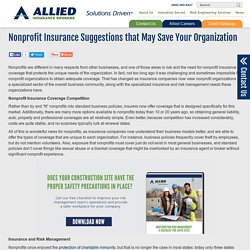
In fact, not too long ago it was challenging and sometimes impossible for nonprofit organizations to obtain adequate coverage. That has changed as insurance companies now view nonprofit organizations as a specialized sector of the overall business community, along with the specialized insurance and risk management needs these organizations have. Nonprofit Insurance Coverage Competition Rather than try and “fit” nonprofits into standard business policies, insurers now offer coverage that is designed specifically for this market. Additionally, there are many more options available to nonprofits today than 10 or 20 years ago, so obtaining general liability, auto, property and professional coverages are all relatively simple.
Is Your Insurance Protecting You from Pollution Risks? Construction sites and other industrial facilities offer many challenges and dangers to those working on-site and to the surrounding communities.
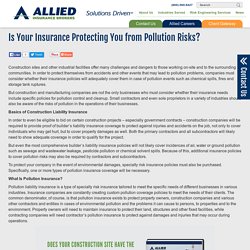
In order to protect themselves from accidents and other events that may lead to pollution problems, companies must consider whether their insurance policies will adequately cover them in case of pollution events such as chemical spills, fires and storage tank ruptures. But construction and manufacturing companies are not the only businesses who must consider whether their insurance needs include specific policies for pollution control and cleanup. Small contractors and even sole proprietors in a variety of industries should also be aware of the risks of pollution in the operations of their businesses. Basics of Construction Liability Insurance To protect your company in the event of environmental damages, specialty risk insurance policies must also be purchased.
Dispelling the 5 Most Common Workers Comp Myths. Workers compensation insurance is an important tool for protecting both employees and employers in today’s workforce.

It’s important to know your rights and to make sure your employees know their rights in case of injury on the job. There are many myths that have circulated over the years regarding workers comp. Here are five of them. 1. Small Businesses with Few Employees Don’t Need Workers Compensation Insurance Actually, the reverse is probably true. Volunteer Liability: How to Keep Your Team Protected. Nonprofit insurance coverage provides your nonprofit with risk management solutions in the event that a loss occurs.
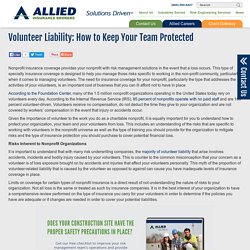
This type of specialty insurance coverage is designed to help you manage those risks specific to working in the non-profit community, particularly when it comes to managing volunteers. The need for insurance coverage for your nonprofit, particularly the type that addresses the activities of your volunteers, is an important cost of business that you can ill afford not to have in place.
According to the Foundation Center, many of the 1.5 million nonprofit organizations operating in the United States today rely on volunteers every day. According to the Internal Revenue Service (IRS), 85 percent of nonprofits operate with no paid staff and are 100 percent volunteer-driven. Stop Worrying with the Top 3 Springtime Weather Worksite Safety Tips.
The old saying goes that April’s showers bring May’s flowers.
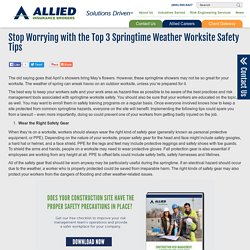
However, these springtime showers may not be so great for your worksite. The weather of spring can wreak havoc on an outdoor worksite, unless you’re prepared for it. 4 Tips to Avoid Logging Equipment Accidents. Operating a logging company or one that handles wood products comes with a significant potential for loss and harm to your employees.

This loss and harm can result from the improper use of heavy equipment necessary for your operations, or accidents that may or may not be the fault of your employees. Lumber insurance companies provide you with ways to mitigate some of the financial loss associated with logging equipment accidents. Controlling Losses on the Construction Site. Risk management services provide your construction company with the assistance you need in order to manage potential loss.
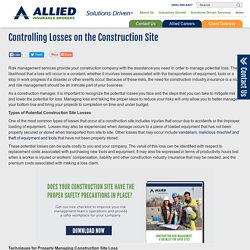
The likelihood that a loss will occur is a constant, whether it involves losses associated with the transportation of equipment, tools or a stop in work progress if a disaster or other events occur. Because of these risks, the need for construction industry insurance is a must and risk management should be an intricate part of your business. As a construction manager, it is important to recognize the potential losses you face and the steps that you can take to mitigate risk and lower the potential for loss. What An Aging Work Force Means For Your Workers Comp Needs. The number of workers who can be classified as aging has increased by an enormous percentage in the last few years.
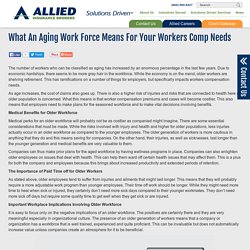
Due to economic hardships, there seems to be more gray hair in the workforce. While the economy is on the mend, older workers are shelving retirement. This has ramifications on a number of things for employers, but specifically impacts workers compensation needs. As age increases, the cost of claims also goes up. Protecting Your Construction Company with the Proper Insurance. Protecting your construction company with proper insurance is crucial to having long-term success in the business.

As skilled as you may be in your job, there are always circumstances beyond your control. If something goes wrong on your construction site, you’ll want to protect your profits, staff, and investments through insurance policies. Here are common policies that construction insurance companies offer: Builder’s Risk Insurance Construction sites are susceptible to sustaining damages because areas are exposed and unfinished. Daily Inspection Checklist for Your Company’s Cranes. Rigging is an important part of construction employment. It is used to lift heavy materials with cranes and other machinery. Riggers also pose as signalmen. Not properly rigging of a load can expose riggers and co-workers nearby to a variety of hazards. Cutting down on accidents through a successful program, your company can not only increase its productivity, but eliminate the risk for a high-cost OSHA fine or lawsuit. Attention to Detail When lifting heavy loads, having a keen eye to every detail is serious.
Scaffolding Safety Tips for the Winter Months Ahead. Winter is one of the most dangerous times of year for construction workers. Rapid weather changes, low temperatures, falling snow and ice represent just a small sampling of the problems construction workers face on the job each and every day. When unpredictable winter weather hits, make sure your site stays safe with these routine checks and procedures. Understanding the Common Causes for Accidents Over the years, the most common causes for accidents are under-trained employees who don’t let their manager know they don’t have the proper training, using incorrect tools, not inspecting the scaffold before mounting, not following procedure and goofing off. Long way up and long way down is the phrase used on a scaffold. Follow Maintenance Procedure Before you mount the scaffold, inspect it to be sure the boards are sound and nothing is visibly damaged. When employees continue to work in rain, sleet or snow, they put their lives at risk.
Preparing and Emergency Plan for Your Construction Site. Anyone in the construction business knows that being organized is one of the keys to success. Another important element to long-term success in building is having a strong handle on the risk management solution for nearly any contingency that may occur. Controlling Workers' Comp Claims Costs.
A large portion of company finances is spent on worker’s compensation claims and their associated costs. Clearly the old adage, “An ounce of prevention is worth a pound of cure,” rings true here. While companies work hard at prevention and safety education, there is always more that can be done. Make sure your company is doing everything it can to keep workplace accidents at a minimum. Preparing for Wintertime Worksite Risks. Construction is a challenging business in itself. Keeping to timelines and managing contractors isn’t always easy, but when you throw winter into the mix, new complications arise. Avoiding the Most Common Logging & Lumberyard Accidents. Every year logging routinely occupies either the first or second position as the statistical winner for most dangerous profession in the United States, since more accidents resulting in injury and fatality occur in the logging industry than virtually any other.
Adding to the severity of logging injuries is the fact that when logging injuries occur, they are almost always at locations remote from professional medical care. 6 Point Safety Inspection for Your Scaffolding. The Do's and Dont's of Concrete Pumping. Concrete pumping provides the fastest and most economical method for placing concrete on construction jobs. However, the process is not without danger and often presents numerous hazards.
To prevent accidents on the job, these do’s and don’ts of concrete pumping should always be on your mind. Contractor Responsibilities. Improving the Safety of Concrete Pumping Equipment. Everything and every person around a concrete pumping operation should be contributing to the safe operation of the pump, and when this is in fact the case, effective concrete pumping is the usual result. Advantages of Specialized Crane Insurance. What Do You Do if Someone is Injured on Your Equipment. There is an enormous industry in North American involved with equipment rentals, and the 12,000-plus companies offering these services provide both heavy equipment and light tools to consumers who find it more cost effective to rent rather than purchase them. Generally speaking, the kinds of equipment being rented fall into three major categories: special event equipment (tents, furniture, party inflatables), general tools (rototillers, chainsaws, floor care equipment), and industrial or construction equipment (backhoes, air compressors, and scaffolding).
Protecting Yourself from the Most Dangerous Construction Risks. Whether you are a construction worker, are currently managing a site, or own a construction company, you’re probably aware that safety should always be a top priority. When you prepare for some of the most common site risks in the industry, you may spare yourself and others from injury. 6 Reasons Riggers Need Insurance. Riggers work in dangerous conditions as they move objects weighing several tons, work at tall heights, and continue working in inclement weather.
The potential for falls and accidents are quite high, causing the need for safety training and adequate insurance protection. Slide Show: Types of Liability for Crane Operators & Businesses.
What Level of Crane Insurance Coverage Should I Buy? What Types of Insurance Should Nonprofits Have?